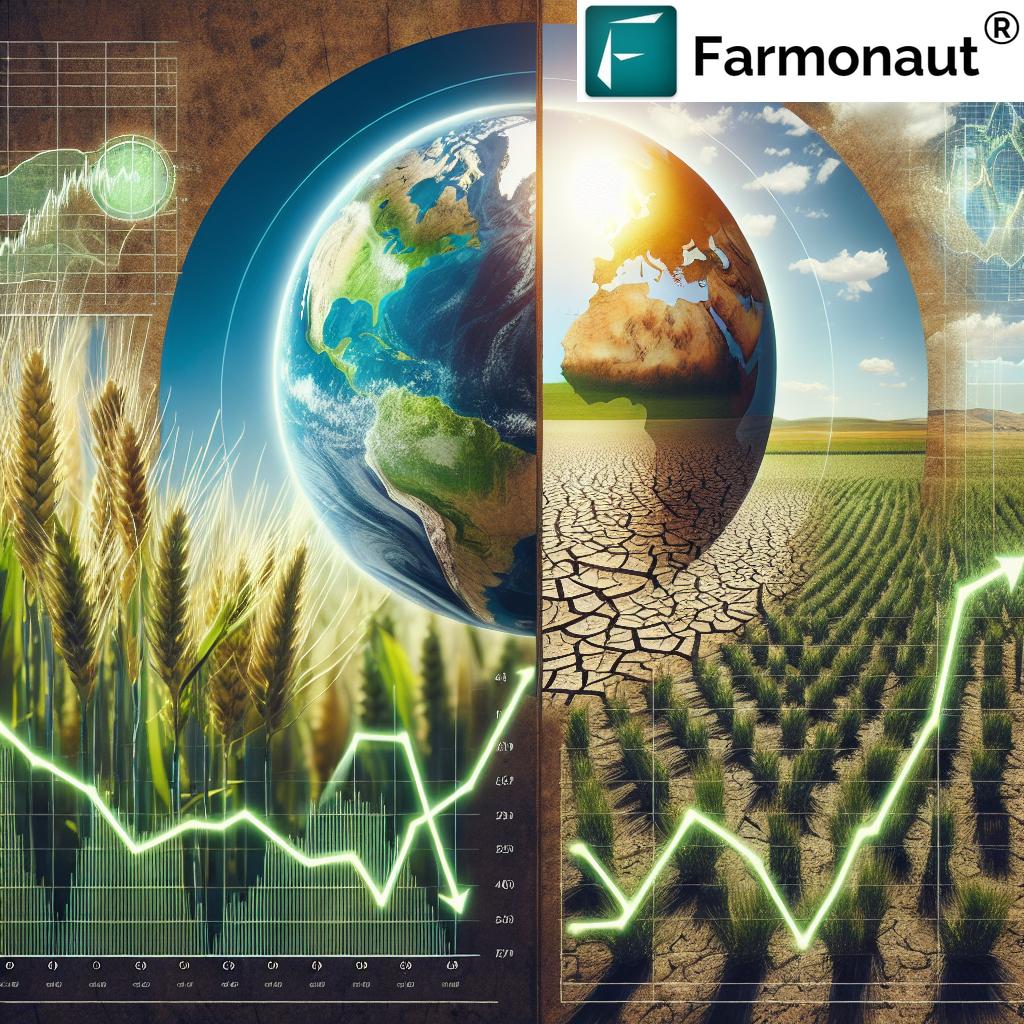Global Wheat and Oilseed Rape Market Analysis: Key Trends and Forecasts for Farmers
“Global wheat production reached a record 773 million tonnes in 2020, influencing market prices and farmer strategies.”
In today’s ever-evolving agricultural landscape, staying informed about market trends is crucial for farmers and agribusiness professionals. At Farmonaut, we recognize the importance of providing comprehensive insights into the global wheat and oilseed rape markets. Our analysis delves deep into the complex factors shaping these vital commodities, offering valuable forecasts to help you make informed decisions for your farm or agricultural enterprise.

The Current State of Global Wheat Markets
The wheat market has experienced significant fluctuations in recent years, driven by a combination of factors including weather patterns, global grain supply, and geopolitical events. As we analyze the current state of the market, several key trends emerge:
- Record Production Levels: Global wheat production has reached unprecedented heights, with many key producing regions experiencing favorable growing conditions.
- Price Volatility: Despite robust production, wheat prices have shown considerable volatility due to factors such as export restrictions and changing demand patterns.
- Shifting Trade Dynamics: International crop trade has been impacted by evolving trade agreements and geopolitical tensions, reshaping traditional export-import relationships.
To stay ahead in this dynamic market, farmers and agribusinesses can leverage advanced technologies like those offered by Farmonaut. Our satellite-based crop health monitoring system provides real-time insights into wheat field conditions, helping optimize farm management strategies.
Oilseed Rape: A Market in Transition
The oilseed rape market presents a unique set of challenges and opportunities for farmers. Our analysis reveals several critical factors influencing this sector:
- Biodiesel Demand: The growing emphasis on renewable energy sources continues to drive demand for oilseed rape as a key biodiesel feedstock.
- Competition with Palm Oil: Fluctuations in the palm oil market significantly impact oilseed rape prices, creating a complex interplay between these two commodities.
- Climate Resilience: Oilseed rape’s adaptability to various climatic conditions makes it an attractive option for farmers looking to diversify their crop portfolio in the face of changing weather patterns.
At Farmonaut, we understand the importance of precision agriculture in maximizing oilseed rape yields. Our AI-powered advisory system, Jeevn AI, provides personalized recommendations for optimal crop management, helping farmers navigate the complexities of oilseed rape cultivation.
Weather Impacts on Global Harvests
The profound influence of weather on crop yields cannot be overstated. Recent years have seen significant weather-related challenges affecting both wheat and oilseed rape production:
- Drought Conditions: Prolonged dry spells in key growing regions have impacted crop development and yields.
- Excessive Rainfall: In contrast, some areas have experienced unusually high precipitation, leading to waterlogging and disease pressure.
- Temperature Fluctuations: Unseasonable temperature patterns have affected crop growth stages, potentially impacting final yields.
Farmonaut’s remote sensing technology allows farmers to monitor these weather impacts in real-time, enabling swift responses to changing conditions. Our satellite imagery provides valuable insights into soil moisture levels, crop health, and potential pest or disease outbreaks.
Commodity Price Fluctuations: Navigating Uncertainty
The global agricultural market is experiencing heightened price volatility, affecting both wheat and oilseed rape. Key factors contributing to these fluctuations include:
- Supply Chain Disruptions: Global events have led to logistical challenges, impacting the movement of agricultural commodities.
- Currency Exchange Rates: Fluctuations in major currencies affect export competitiveness and import costs for agricultural products.
- Speculative Trading: Increased participation of non-traditional investors in commodity markets can amplify price movements.
To help farmers navigate these uncertain waters, Farmonaut offers comprehensive market analysis tools. Our platform integrates real-time price data with crop production forecasts, enabling informed decision-making on when to sell or store harvested crops.
“Oilseed rape prices have fluctuated up to 30% annually due to biodiesel demand and palm oil market trends.”
Global Grain Supply: Balancing Act
The delicate balance of global grain supply plays a crucial role in determining market prices and farm profitability. Our analysis reveals several key trends:
- Increasing Production Efficiency: Advancements in agricultural technology and farming practices have led to higher yields in many regions.
- Shifting Consumption Patterns: Changes in global dietary habits and population growth are reshaping demand for wheat and oilseed products.
- Strategic Reserves: Many countries are reassessing their grain storage policies, impacting global supply dynamics.
Farmonaut’s crop area estimation technology provides valuable insights into global production trends. By leveraging satellite data and machine learning algorithms, we offer accurate forecasts of crop yields, helping stakeholders across the agricultural value chain make informed decisions.
International Crop Trade: Evolving Dynamics
The landscape of international crop trade is undergoing significant transformations, influenced by various factors:
- Trade Agreements: New and renegotiated trade deals are reshaping traditional export-import relationships.
- Phytosanitary Regulations: Increasingly stringent quality and safety standards are impacting the flow of agricultural commodities across borders.
- Emerging Markets: Rising demand from developing economies is creating new opportunities for wheat and oilseed rape exporters.
At Farmonaut, we recognize the importance of traceability in international trade. Our blockchain-based product traceability solution ensures transparency and trust throughout the supply chain, from farm to consumer.
Farm Management Strategies for Success
In light of the complex market dynamics, adopting effective farm management strategies is crucial for success in wheat and oilseed rape production. We recommend focusing on:
- Precision Agriculture: Utilize technologies like Farmonaut’s satellite-based crop monitoring to optimize resource use and maximize yields.
- Diversification: Consider incorporating a mix of crops to spread risk and capitalize on different market opportunities.
- Sustainable Practices: Implement environmentally friendly farming methods to meet growing consumer demand for sustainable products and potentially access premium markets.
- Data-Driven Decision Making: Leverage market analysis tools and crop forecasting models to inform planting, harvesting, and selling decisions.
Farmonaut’s comprehensive suite of farm management tools, including our AI-powered advisory system and carbon footprinting feature, empowers farmers to implement these strategies effectively.

Crop Yield Forecasts: Looking Ahead
Accurate crop yield forecasts are essential for both farmers and market analysts. Our latest projections for wheat and oilseed rape yields consider various factors:
- Climate Trends: Long-term weather patterns and their potential impact on crop development.
- Technological Advancements: The adoption of new farming technologies and their effect on productivity.
- Pest and Disease Pressures: Anticipated challenges from crop pests and diseases, and their potential impact on yields.
Farmonaut’s advanced remote sensing capabilities and AI-driven analytics provide highly accurate crop yield forecasts. By combining satellite imagery with ground-level data and historical trends, we offer farmers and agribusinesses valuable insights for strategic planning.
The Role of Currency Exchange Rates
Currency fluctuations play a significant role in the global wheat and oilseed rape markets, affecting both import costs and export competitiveness. Key considerations include:
- Export Opportunities: A weaker domestic currency can make exports more attractive, potentially boosting demand for locally produced wheat and oilseed rape.
- Input Costs: Currency strength impacts the cost of imported farm inputs such as fertilizers and machinery, affecting overall production costs.
- Market Access: Exchange rate movements can influence the relative competitiveness of different exporting countries in international markets.
At Farmonaut, we integrate currency exchange rate data into our market analysis tools, helping farmers and agribusinesses make informed decisions in the global marketplace.
Sustainable Agriculture: A Growing Imperative
The shift towards sustainable agriculture is increasingly influencing market dynamics for wheat and oilseed rape. Key trends include:
- Organic Production: Growing consumer demand for organic products is creating new market opportunities for farmers.
- Regenerative Practices: Techniques that improve soil health and biodiversity are gaining traction, potentially impacting yields and production costs.
- Carbon Markets: Emerging opportunities for farmers to participate in carbon credit schemes are adding a new dimension to farm profitability.
Farmonaut’s carbon footprinting feature helps farmers quantify and manage their environmental impact, positioning them to capitalize on these emerging trends in sustainable agriculture.
Market Comparison: Wheat vs. Oilseed Rape
To provide a clear overview of the current market dynamics, we’ve compiled a comparison of key factors affecting wheat and oilseed rape markets:
| Market Factors | Wheat | Oilseed Rape |
|---|---|---|
| Global Production (est. million tonnes) | 773 | 68 |
| Price Trend | Stable with fluctuations | Increasing |
| Primary Demand Drivers | Food consumption, animal feed | Biodiesel production, food industry |
| Weather Impact on Recent Harvests | Moderate to High | High |
| Export Opportunities | Strong | Growing |
| Biodiesel Influence | Low | High |
| Currency Exchange Rate Impact | Significant | Moderate |
| Short-term Market Forecast | Stable with potential for volatility | Upward trend expected |
This comparison highlights the unique characteristics and challenges of each crop, emphasizing the need for tailored strategies in farm management and market participation.
Leveraging Technology for Market Insights
In today’s data-driven agricultural landscape, leveraging technology is crucial for staying ahead of market trends. Farmonaut’s suite of tools offers several advantages:
- Real-time Monitoring: Our satellite-based crop monitoring provides up-to-date information on crop health and development stages.
- Predictive Analytics: Advanced AI algorithms help forecast potential issues and market trends, enabling proactive decision-making.
- Integration of Multiple Data Sources: By combining satellite imagery, weather data, and market information, we offer a comprehensive view of the agricultural landscape.
Farmers and agribusinesses can access these powerful tools through our user-friendly platform, available on web and mobile applications.
Explore Farmonaut’s API for advanced data integration
The Future of Wheat and Oilseed Rape Markets
As we look to the future, several trends are likely to shape the wheat and oilseed rape markets:
- Climate Adaptation: Development of more resilient crop varieties to withstand changing weather patterns.
- Precision Agriculture: Continued adoption of technologies like those offered by Farmonaut for optimized resource use and yield maximization.
- Changing Consumer Preferences: Increasing demand for plant-based proteins and sustainable food products.
- Policy Shifts: Evolving agricultural policies and trade agreements impacting production and market access.
By staying informed and leveraging cutting-edge technologies, farmers and agribusinesses can position themselves for success in these dynamic markets.
Conclusion: Empowering Farmers in a Changing Landscape
The global wheat and oilseed rape markets present both challenges and opportunities for farmers and agribusinesses. By understanding key trends, leveraging technology, and adopting strategic farm management practices, stakeholders can navigate this complex landscape successfully.
At Farmonaut, we are committed to empowering farmers with the tools and insights needed to thrive in today’s agricultural markets. Our comprehensive platform offers real-time crop monitoring, market analysis, and sustainable farming solutions, all accessible through user-friendly web and mobile applications.
As you plan your farming strategies for the coming seasons, consider how Farmonaut’s advanced technologies can support your decision-making process and help optimize your operations. Together, we can build a more resilient and profitable future for agriculture.
Explore our API Developer Docs for advanced integrations
Frequently Asked Questions (FAQ)
- How does Farmonaut’s satellite monitoring improve crop yield forecasts?
Farmonaut uses high-resolution satellite imagery and advanced AI algorithms to analyze crop health, growth stages, and field conditions. This data is combined with historical yields and weather forecasts to provide accurate yield predictions. - Can Farmonaut’s tools be used for both small-scale and large commercial farms?
Yes, our platform is designed to be scalable and adaptable to farms of all sizes. Whether you’re managing a small family farm or overseeing large-scale agricultural operations, Farmonaut’s tools can be tailored to meet your specific needs. - How often is the market data updated in Farmonaut’s analysis tools?
Our market data is updated in real-time, ensuring that you always have access to the latest information on prices, trends, and forecasts for wheat and oilseed rape markets. - Does Farmonaut provide recommendations for sustainable farming practices?
Yes, our AI-powered advisory system, Jeevn AI, offers personalized recommendations for sustainable farming practices, including optimal resource use and environmentally friendly pest management strategies. - How can I access Farmonaut’s services?
Farmonaut’s services are available through our web application, Android and iOS mobile apps, and API integrations. You can choose the platform that best suits your needs and workflow.







